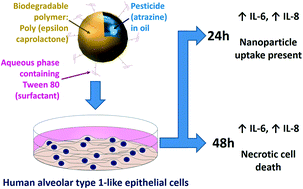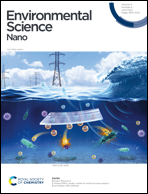Bioreactivity of a novel poly(epsilon-caprolactone) nanocapsule containing atrazine with human lung alveolar epithelial cells†
Abstract
Atrazine (ATZ), a commonly used agricultural herbicide, is potentially harmful to animals and humans. Nanoencapsulation of ATZ (NC–ATZ) within non-toxic, biodegradable poly(ε-caprolactone) (PCL) improves the herbicidal activity of ATZ 10-fold and moderates its environmental persistence, possibly reducing off-target ecological effects. These compounds may reach the pulmonary respiratory units following inhalation; thus, we investigated the effect of ATZ and NC–ATZ on an immortalised human lung alveolar type 1-like epithelial cell model (TT1 cells). The concentration-dependent effect of the compounds was analysed by assessment of viability, reactive oxygen species (ROS) production and inflammatory cytokine release. Confocal microscopy was used to visualise TT1 cell-nanoparticle interactions. NC–ATZ caused cellular effects not observed with ATZ or the PCL nanocapsule alone. NC–ATZ significantly increased lactate dehydrogenase (LDH) release at ≥1 μg ml−1 after 48 hours of exposure, peaking at 5 μg ml−1 (3-fold of the non-treated control, ***p < 0.001). Moreover, ≥1 μg ml−1 NC–ATZ was pro-inflammatory at 48 hours, peaking at 5 μg ml−1 (IL-6 release ∼125 pg ml−1; IL-8 release ∼46 pg ml−1). Confocal microscopy of fluorescently-labelled ATZ and NC–ATZ indicated high intensity fluorescence nanoparticle uptake into the cytoplasm and co-localisation in the Golgi, suggesting nanoparticle recycling within 24 hours. We provide evidence that nanoencapsulation of the pesticide ATZ alters bioreactivity, stimulating more necrosis and inflammation in human lung alveolar type 1 epithelial cells in comparison to ATZ or the PCL nanocapsule alone. However, nanoencapsulation improves the efficacy of pesticides, thus lower pesticide concentrations could be used, reducing environmental contamination. Further investigation, particularly with different exposure scenarios, is warranted in order to generate safer nanoencapsulated pesticides.

- This article is part of the themed collection: Recent Open Access Articles


 Please wait while we load your content...
Please wait while we load your content...